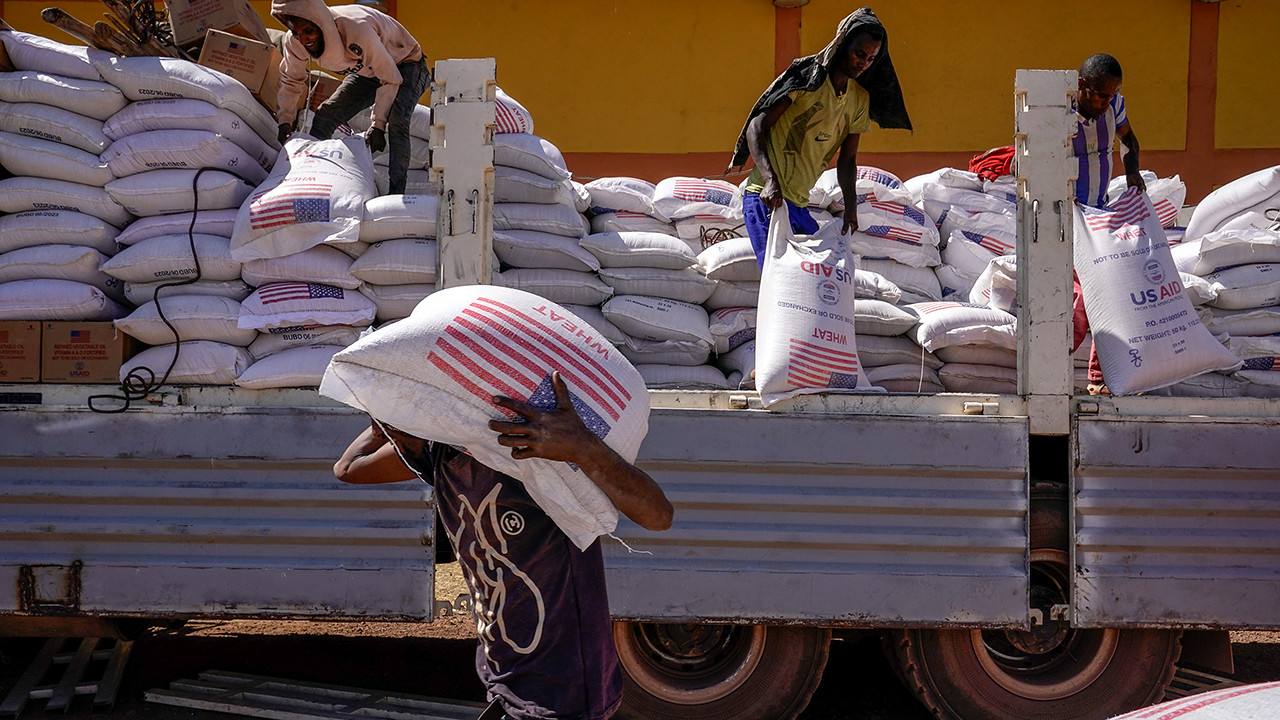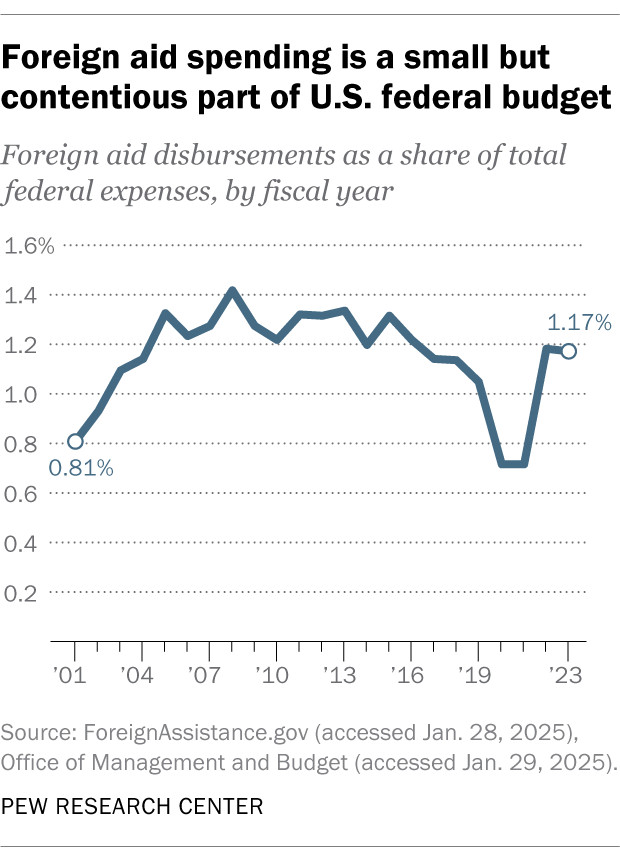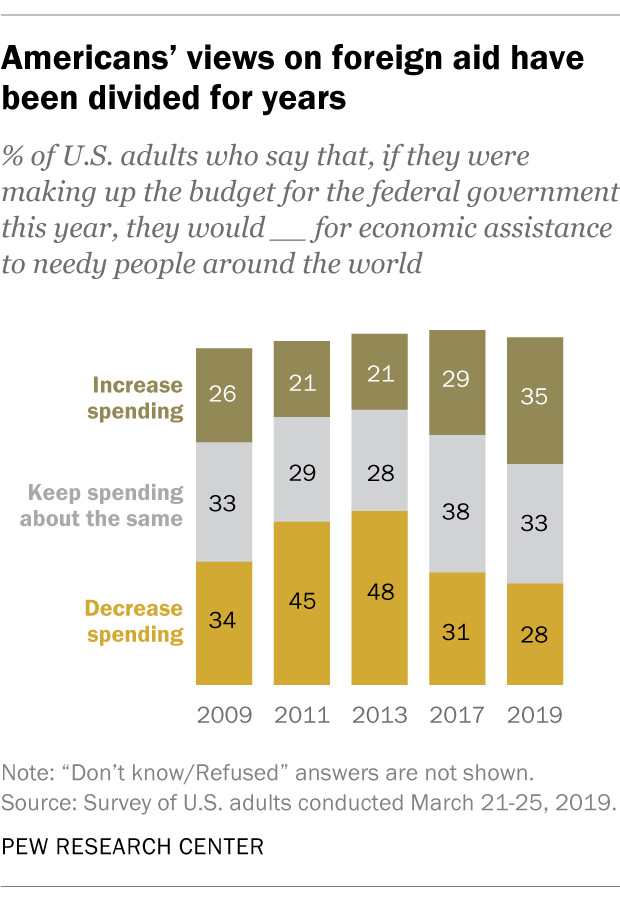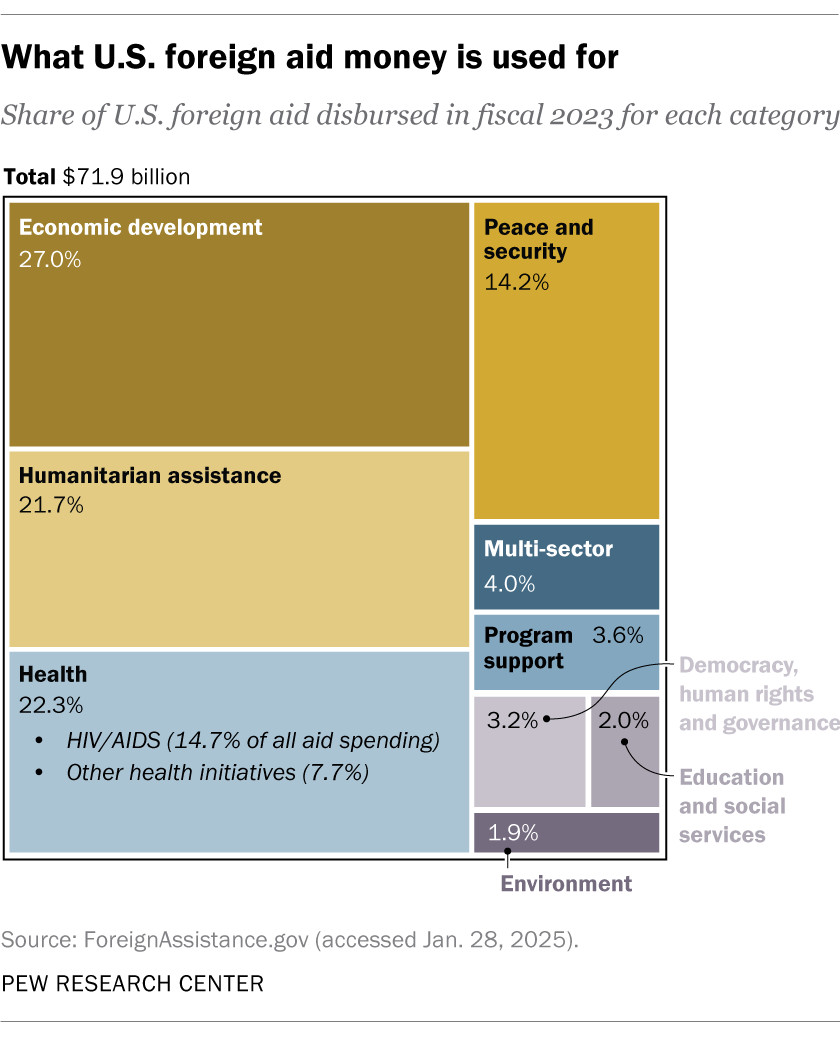How much money does the US send to other countries? The United States’ financial assistance to other nations is a topic of ongoing discussion. At money-central.com, we break down the facts and figures to give you a clear picture of where your tax dollars are going and why. Learn about global impact, economic development, and humanitarian aid.
1. What Is The Total Amount Of U.S. Foreign Aid Spending?
The U.S. government is projected to spend approximately $58.4 billion on international assistance programs for the 2025 fiscal year. However, this figure is subject to change due to evolving policy priorities.
U.S. foreign aid has fluctuated over the years, influenced by global events such as wars, disasters, and disease outbreaks, as well as shifting policy objectives. In fiscal year 2023, the U.S. disbursed $71.9 billion in foreign aid, compared to nearly $74.0 billion in fiscal year 2022, according to ForeignAssistance.gov. These figures do not encompass most arms sales or transfers of military equipment to foreign countries.
 Volunteers unload aid from USAID in Ethiopia, showcasing U.S. humanitarian efforts Us Foreign Aid Spending
Volunteers unload aid from USAID in Ethiopia, showcasing U.S. humanitarian efforts Us Foreign Aid Spending
The United States is the world’s largest aid donor, contributing over 40% of all humanitarian aid tracked by the United Nations in 2024. This commitment underscores the nation’s role in addressing global challenges and supporting international development.
2. How Does U.S. Foreign Aid Compare To The Total Federal Budget?
In fiscal year 2023, the $71.9 billion spent on foreign aid represented 1.2% of the total federal outlays, which exceeded $6.1 trillion. This indicates that while significant, foreign aid constitutes a relatively small portion of the overall federal budget.
Between fiscal years 2001 and 2023, foreign aid ranged from 0.7% to 1.4% of total federal outlays. In comparison, the federal deficit for fiscal year 2023 was nearly $1.7 trillion. During the Cold War era, foreign aid accounted for a larger share of federal spending, reaching approximately 4.7% in fiscal year 1963. However, this share gradually decreased, reaching a low of 0.6% in fiscal year 1989.
 A line chart illustrating foreign aid spending as a percentage of the U.S. federal budget US Federal Budget
A line chart illustrating foreign aid spending as a percentage of the U.S. federal budget US Federal Budget
3. What Are The Primary Uses Of U.S. Foreign Aid Funds?
U.S. foreign aid supports a diverse range of humanitarian, economic development, and democracy-promotion initiatives. While the categories may overlap, the main areas of focus include:
- Macroeconomic Foundation for Growth: In fiscal year 2023, this category received $15.9 billion, or 22.1% of all disbursed aid. A significant portion, $14.4 billion, was direct monetary support to the Ukrainian government during its conflict with Russia.
- Disaster Relief and Humanitarian Aid: This area received $15.6 billion, or 21.7% of total aid disbursements in fiscal year 2023, providing assistance to countries affected by natural disasters and humanitarian crises.
- Combating HIV/AIDS: Efforts to combat HIV/AIDS received $10.6 billion, or 14.7% of total aid, supporting prevention, treatment, and care programs globally.
- Addressing Public Health Threats: Combatting “pandemic influenza” and other emerging public health threats received $1.5 billion, or 2.0% of total aid, enhancing global health security and preparedness.
- Promoting Democracy and Governance: Promoting democracy, good governance, and the rule of law received $2.3 billion, or 3.2% of total aid, supporting democratic institutions and processes worldwide.
- Multi-Sector Programs: Programs that crossed several subject areas received $2.9 billion, or 4.0% of total aid, addressing complex challenges through integrated approaches.
4. Which Countries Are The Top Recipients Of U.S. Foreign Aid?
In fiscal year 2023, U.S. aid supported programs and activities in 177 individual countries and 29 regions, as well as global endeavors. The individual projects were implemented by numerous foreign government agencies, nonprofit groups, international organizations, for-profit companies, and universities.
Ukraine was the largest recipient of U.S. aid, receiving $16.6 billion to support its defense against Russia’s invasion and maintain its government and society. Israel received $3.3 billion in military aid, consistent with recent years. Other significant recipients included Ethiopia, Jordan, Egypt, and Afghanistan.
5. Which Agencies Are Responsible For Distributing U.S. Foreign Aid?
The U.S. Agency for International Development (USAID) has been the primary aid agency since its establishment in 1961. As of March 2024, USAID employed 4,675 people, many of whom worked overseas. In fiscal year 2023, USAID distributed nearly $43.8 billion in aid, accounting for approximately three out of every five foreign-assistance dollars.
The State Department disbursed $21.3 billion in aid in fiscal year 2023, representing almost 30% of the total. Smaller amounts were disbursed by the Treasury and Health and Human Services departments, the Millennium Challenge Corporation, and 16 other agencies.
6. What Is The Extent Of U.S. Military Assistance Programs?
In fiscal year 2023, $8.2 billion of the $71.9 billion in disbursements (11.4%) was designated as military aid. However, the United States’ overall military-assistance efforts are more extensive.
Through the Foreign Military Sales program, approved foreign nations can purchase American weapons, ammunition, equipment, and services, with the U.S. government acting as an intermediary. In fiscal year 2024, such sales totaled $117.9 billion, up from $80.9 billion in fiscal year 2023.
Allies and partner nations can also purchase arms from their manufacturers independently, without U.S. government involvement. These “direct commercial sales” are regulated by law and totaled $200.8 billion in fiscal year 2024, up from $157.5 billion in fiscal year 2023.
7. What Percentage Of U.S. Foreign Aid Is Tied To Specific Goods Or Services?
A portion of U.S. foreign assistance is “tied aid,” meaning it requires recipient countries to purchase goods or services from the United States. While the exact percentage varies, it is intended to support U.S. industries and promote American exports.
Tied aid can ensure quality and compatibility with existing systems, but it may also limit recipient countries’ ability to seek the most cost-effective solutions or develop their own industries. Striking a balance between promoting U.S. interests and supporting sustainable development in recipient countries is a key consideration in aid policy.
8. Are There Oversight Mechanisms In Place To Ensure U.S. Foreign Aid Is Used Effectively And Accountably?
Yes, various oversight mechanisms are in place to ensure U.S. foreign aid is used effectively and accountably. These include:
- Monitoring and Evaluation: U.S. agencies conduct regular monitoring and evaluation of aid programs to assess their impact and identify areas for improvement.
- Audits and Inspections: Independent audits and inspections are carried out to ensure funds are used for their intended purposes and in compliance with regulations.
- Reporting Requirements: Recipient countries and organizations are required to provide regular reports on how U.S. aid funds are being used.
- Congressional Oversight: Congress plays a crucial role in overseeing U.S. foreign aid through hearings, investigations, and legislation.
These mechanisms help to promote transparency, accountability, and effectiveness in U.S. foreign aid programs.
9. How Do Americans Feel About The Amount And Effectiveness Of U.S. Foreign Aid?
Public opinion on the effectiveness and desirability of foreign assistance has historically been mixed.
Pew Research Center surveys have consistently found split opinions on “economic assistance to needy people around the world.” A 2019 telephone survey revealed that 35% of U.S. adults wanted to increase spending on such aid, 33% wanted to keep it the same, and 28% wanted to decrease it.
In a March 2023 online survey, only a third of Americans believed U.S. foreign aid mostly benefits developing countries, while 37% said it both benefits and harms these countries, and 8% believed it mostly harms them. A significant share (17%) expressed uncertainty.
 A stacked bar chart illustrating American attitudes toward economic assistance to needy people globally.
A stacked bar chart illustrating American attitudes toward economic assistance to needy people globally.
When considering Americans’ foreign policy goals, priorities such as domestic security are emphasized. In a 2024 online survey, 73% of U.S. adults prioritized protecting the country from terrorist attacks, 64% prioritized reducing illegal drug flows, and 52% prioritized reducing infectious disease spread. In contrast, only 26% prioritized promoting human rights, and 18% prioritized promoting democracy in other nations.
10. How Does U.S. Foreign Aid Align With Broader Foreign Policy Objectives?
U.S. foreign aid aligns with various foreign policy objectives, including:
- National Security: Aid is often directed towards countries critical to U.S. national security interests, such as those combating terrorism or facing geopolitical threats.
- Economic Development: Aid supports economic growth and stability in developing countries, promoting trade and investment opportunities for the U.S.
- Humanitarian Assistance: Aid provides relief and support to countries affected by natural disasters, conflicts, and humanitarian crises, enhancing the U.S.’s reputation as a global leader.
- Diplomacy and Influence: Aid strengthens relationships with foreign governments and populations, enhancing U.S. influence and promoting its values abroad.
By aligning aid with these objectives, the U.S. aims to advance its interests while contributing to global stability and prosperity.
11. What Are The Criticisms Of U.S. Foreign Aid Programs?
U.S. foreign aid programs face several criticisms, including:
- Inefficiency and Waste: Some critics argue that aid programs are often inefficient and wasteful, with funds being mismanaged or diverted to unintended purposes.
- Lack of Accountability: Concerns exist regarding the lack of accountability and transparency in aid programs, making it difficult to track how funds are being used and whether they are achieving their intended outcomes.
- Dependency: Critics argue that aid can create dependency in recipient countries, hindering their ability to develop sustainable economies and institutions.
- Political Motivations: Some believe that aid is often used as a tool to advance U.S. political interests, rather than to address the needs of recipient countries.
- Tied Aid: The practice of tying aid to the purchase of U.S. goods and services is criticized for limiting recipient countries’ ability to seek the most cost-effective solutions.
Addressing these criticisms is essential to improve the effectiveness and impact of U.S. foreign aid programs.
12. What Are The Potential Benefits Of U.S. Foreign Aid?
U.S. foreign aid can offer several potential benefits, including:
- Poverty Reduction: Aid can help reduce poverty by supporting economic growth, education, healthcare, and other essential services in developing countries.
- Improved Health Outcomes: Aid can improve health outcomes by supporting programs that combat diseases, promote maternal and child health, and strengthen healthcare systems.
- Economic Growth: Aid can stimulate economic growth by supporting infrastructure development, trade, and investment in developing countries.
- Democracy and Governance: Aid can promote democracy and good governance by supporting democratic institutions, civil society organizations, and human rights initiatives.
- Global Stability: Aid can contribute to global stability by addressing the root causes of conflict, promoting peace and security, and fostering cooperation among nations.
By realizing these benefits, U.S. foreign aid can contribute to a more prosperous, healthy, and secure world.
13. How Can U.S. Foreign Aid Be Made More Effective?
Several strategies can enhance the effectiveness of U.S. foreign aid:
- Focus on Results: Prioritize aid programs that demonstrate clear results and impact, using evidence-based approaches and rigorous monitoring and evaluation.
- Promote Local Ownership: Empower recipient countries to take ownership of aid programs, aligning them with their development priorities and building local capacity.
- Enhance Coordination: Improve coordination among U.S. agencies, international organizations, and other donors to avoid duplication and maximize impact.
- Increase Transparency: Increase transparency in aid programs, making information on funding, activities, and results publicly available.
- Strengthen Accountability: Strengthen accountability mechanisms to ensure funds are used for their intended purposes and in compliance with regulations.
- Address Root Causes: Focus on addressing the root causes of poverty, conflict, and instability, rather than just treating the symptoms.
- Invest in Innovation: Invest in innovative approaches and technologies to improve the delivery and impact of aid programs.
By implementing these strategies, U.S. foreign aid can become more effective in achieving its goals and contributing to global development.
14. What Role Does Private Philanthropy Play In International Aid?
Private philanthropy plays a significant role in international aid, complementing government efforts and providing additional resources for development. Private foundations, corporations, and individuals contribute billions of dollars annually to support a wide range of causes, including poverty reduction, healthcare, education, and disaster relief.
Private philanthropy offers several advantages:
- Flexibility: Private donors can be more flexible and responsive to emerging needs than government agencies.
- Innovation: Private donors can take risks and invest in innovative approaches that may not be supported by traditional aid programs.
- Efficiency: Private donors can often operate more efficiently than government agencies, with lower overhead costs and streamlined processes.
- Accountability: Private donors are often held to high standards of accountability by their donors and the public.
By working in partnership with government agencies, international organizations, and local communities, private philanthropy can play a vital role in addressing global challenges and promoting sustainable development.
15. What Is The Future Of U.S. Foreign Aid?
The future of U.S. foreign aid is subject to ongoing debate and uncertainty, influenced by changing political priorities, economic conditions, and global challenges.
Several trends may shape the future of U.S. foreign aid:
- Increased Focus on National Interests: There may be a greater emphasis on aligning aid with U.S. national interests, such as promoting security, trade, and investment.
- Greater Scrutiny and Accountability: Aid programs may face greater scrutiny and demands for accountability, with a focus on results and impact.
- Shift Towards Private Sector Engagement: There may be a greater emphasis on engaging the private sector in development efforts, leveraging private capital and expertise.
- Increased Competition from Other Donors: The U.S. may face increased competition from other donors, such as China, which are expanding their foreign aid programs.
- Evolving Global Challenges: New and evolving global challenges, such as climate change, pandemics, and cyber threats, may require new approaches to foreign aid.
Navigating these trends will be essential to ensure that U.S. foreign aid remains effective, relevant, and aligned with the nation’s values and interests.
16. What Are The Long-Term Impacts Of U.S. Foreign Aid On Recipient Countries?
The long-term impacts of U.S. foreign aid on recipient countries are complex and multifaceted, varying depending on the type of aid, the context in which it is delivered, and the policies and institutions of the recipient country.
Potential long-term impacts include:
- Economic Development: Aid can contribute to long-term economic development by supporting infrastructure, education, and trade, leading to increased incomes and improved living standards.
- Poverty Reduction: Aid can help reduce poverty by providing essential services, promoting economic opportunities, and empowering marginalized groups.
- Improved Health Outcomes: Aid can improve long-term health outcomes by strengthening healthcare systems, preventing diseases, and promoting healthy behaviors.
- Democracy and Governance: Aid can support the development of democratic institutions, the rule of law, and civil society, leading to greater political stability and citizen participation.
- Environmental Sustainability: Aid can promote environmental sustainability by supporting conservation efforts, renewable energy, and sustainable agriculture.
However, aid can also have negative long-term impacts if it is not well-designed or implemented, such as creating dependency, distorting markets, or undermining local institutions. Maximizing the positive long-term impacts of aid requires careful planning, implementation, and evaluation, as well as strong partnerships with recipient countries.
17. How Does U.S. Foreign Aid Compare To That Of Other Developed Countries?
The U.S. is the largest donor of foreign aid in absolute terms, but when measured as a percentage of gross national income (GNI), it ranks lower compared to other developed countries.
According to the Organization for Economic Cooperation and Development (OECD), several countries, including Norway, Sweden, Luxembourg, and Denmark, consistently exceed the United Nations’ target of providing 0.7% of GNI as official development assistance (ODA). The U.S. has historically provided less than 0.2% of GNI as ODA.
 A chart comparing U.S. foreign aid spending with other countries Us Foreign Aid Compared
A chart comparing U.S. foreign aid spending with other countries Us Foreign Aid Compared
Comparing aid levels as a percentage of GNI provides a more accurate picture of a country’s commitment to foreign aid relative to its economic capacity. While the U.S. provides significant aid in absolute terms, other developed countries allocate a larger share of their resources to international development.
18. What Are The Ethical Considerations Involved In U.S. Foreign Aid?
U.S. foreign aid raises several ethical considerations, including:
- Responsibility to Alleviate Suffering: There is an ethical argument that wealthy countries have a responsibility to alleviate suffering and promote well-being in less developed countries.
- National Interests vs. Humanitarian Concerns: Balancing national interests with humanitarian concerns in aid allocation decisions can raise ethical dilemmas.
- Respect for Sovereignty: Respecting the sovereignty and autonomy of recipient countries while ensuring aid is used effectively and accountably requires careful consideration.
- Transparency and Accountability: Ensuring transparency and accountability in aid programs is essential to maintain public trust and prevent corruption.
- Do No Harm: Aid programs should be designed and implemented in a way that minimizes potential harm to recipient countries, such as distorting markets or undermining local institutions.
Addressing these ethical considerations is essential to ensure that U.S. foreign aid is morally justifiable and contributes to a more just and equitable world.
19. What Role Do Non-Governmental Organizations (NGOs) Play In Delivering U.S. Foreign Aid?
Non-governmental organizations (NGOs) play a crucial role in delivering U.S. foreign aid, often serving as implementing partners for U.S. government agencies and providing essential services in developing countries.
NGOs offer several advantages:
- Local Knowledge and Expertise: NGOs often have deep local knowledge and expertise, allowing them to tailor aid programs to the specific needs and contexts of recipient communities.
- Community Engagement: NGOs can engage directly with communities, building trust and ensuring that aid programs are responsive to local priorities.
- Flexibility and Innovation: NGOs can be more flexible and innovative than government agencies, adapting their programs to changing circumstances and experimenting with new approaches.
- Cost-Effectiveness: NGOs can often deliver aid more cost-effectively than government agencies, with lower overhead costs and streamlined processes.
By partnering with NGOs, U.S. government agencies can leverage their expertise and reach to deliver aid more effectively and sustainably.
20. How Does U.S. Foreign Aid Address Global Challenges Such As Climate Change, Pandemics, And Food Security?
U.S. foreign aid plays a critical role in addressing global challenges such as climate change, pandemics, and food security.
- Climate Change: Aid supports climate mitigation and adaptation efforts, such as promoting renewable energy, protecting forests, and building resilience to climate impacts.
- Pandemics: Aid strengthens global health security, supports disease surveillance and prevention, and provides essential resources for pandemic response.
- Food Security: Aid promotes sustainable agriculture, improves nutrition, and supports food assistance programs to address hunger and malnutrition.
By investing in these areas, U.S. foreign aid can help build a more sustainable, resilient, and equitable world.
Understanding how much money the US sends to other countries, where it goes, and what impact it has is crucial for informed citizenship. At money-central.com, we strive to provide clear, concise, and data-driven analyses to help you make sense of complex financial topics.
For more in-depth information and resources on U.S. foreign aid, visit money-central.com. Explore our articles, tools, and expert advice to gain a comprehensive understanding of global economics, development assistance, and international finance.
Address: 44 West Fourth Street, New York, NY 10012, United States.
Phone: +1 (212) 998-0000.
Website: money-central.com.
Frequently Asked Questions (FAQ) About U.S. Foreign Aid
1. What is the definition of foreign aid?
Foreign aid refers to the financial or other assistance provided by one country to another, typically to support economic, social, or political development.
2. What are the main goals of U.S. foreign aid?
The main goals include promoting economic growth, reducing poverty, improving health, strengthening democracy, and fostering global stability.
3. How is U.S. foreign aid money allocated?
The money is allocated based on various factors, including national interests, humanitarian needs, and policy priorities, with decisions made by Congress and U.S. government agencies.
4. Which countries receive the most U.S. foreign aid?
Historically, the largest recipients have included countries like Afghanistan, Israel, Egypt, and Jordan, although amounts can vary based on current global events and policy decisions.
5. Is U.S. foreign aid effective in achieving its goals?
The effectiveness of U.S. foreign aid is a topic of debate, with some studies showing positive impacts and others raising concerns about inefficiency or unintended consequences.
6. How does U.S. foreign aid compare to other developed countries?
The U.S. is the largest donor in absolute terms, but when measured as a percentage of gross national income (GNI), it ranks lower compared to other developed countries.
7. Are there any conditions attached to U.S. foreign aid?
Yes, aid may come with conditions related to economic policies, human rights, or governance, which are intended to promote responsible use of funds and align with U.S. values.
8. What is the role of USAID in distributing foreign aid?
USAID is the primary U.S. government agency responsible for administering civilian foreign aid and development assistance.
9. How can I find more information about U.S. foreign aid spending?
You can find detailed information on websites like ForeignAssistance.gov and the U.S. Department of State, as well as reports from organizations like the Congressional Research Service.
10. What are the major criticisms of U.S. foreign aid programs?
Criticisms include concerns about inefficiency, lack of accountability, dependency, and the potential for aid to be used for political purposes rather than genuine development.